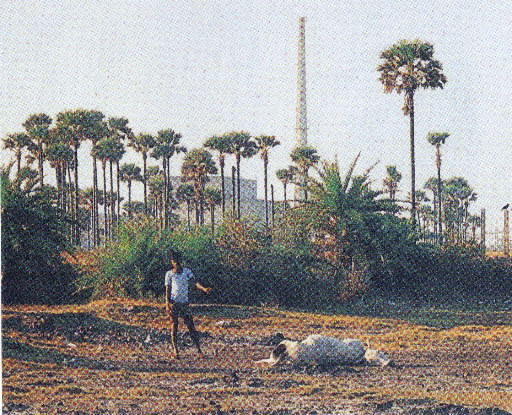1. The Dirtiest Nuclear Facility in the World
Feb. 21, 2013
Chapter 4: India, Malaysia, Korea
Part 1: Living in the Shadow of Indian Nuclear Development
Part 1: Living in the Shadow of Indian Nuclear Development
India, which shocked the world when it carried out an underground nuclear test in 1 974, possesses all the facilities required for making atomic fuel, from uranium mines to fast-breeder reactors and fuel reprocessing plants. The country prides itself on being at the forefront of nuclear technology among the developing nations, but when we traveled in India we found the people living near these facilities were poor and, almost without exception, were unaware of the dangers of radioactive contamination. These are the people who have been forgotten in the eagerness of the Indian government to catch up with the big boys of nuclear development.
1. The Dirtiest Nuclear Facility in the World
Our first destination was the village of Akarpatti, three hours north of Bombay by road. Situated on the Arabian Sea coast, the village has a population of two thousand. Across the wide estuary, a grove of palm trees conceals a nuclear power plant. Only one mile away from Akarpatti, the Tarapur Nuclear Complex houses India's first two reactors, bought from the United States and operating since 1969, and a plant for reprocessing used nuclear fuel. Through our interpreter we explained to the villagers our reason for coming to Akarpatti. We were the first journalists, foreign or domestic, ever to set foot in the area, and at first the residents were wary of speaking to us. After a while, though, they gradually began to respond to our questions, and we realized there was a lot they wanted to tell us.
Dattatraya Patil, who could speak English, told us that the palm trees had been wilting recently, something which had never happened before.
"Look," he said, pointing out trees as he showed us around the village, "there's one here, and some over there, too." The trees, all over thirty feet tall, had lost their leaves and had been reduced to pathetic shadows of their former selves.
As we were walking around the village, the group swelled until there were perhaps thirty men following us. One of them, Shri Patil, an electrician, told us that in recent years a lot of cattle had died after wandering across the estuary in search of feed. Nobody knew the reason, but the people had begun to cast suspicion at the nuclear plant tucked away inconspicuously among the palms.
The Tarapur Nuclear Complex has an unenviable reputation as the dirtiest nuclear facility in the world, due to the frequent accidents there. In September 1989, two of India's leading English-language dailies reported that highly radioactive iodine had been detected in seaweed gathered in the area.
According to the scientists from the Bhabha Atomic Research Center in Bombay who had published the results in a marine science journal, the amount of iodine-129 found at Tarapur was 740 times the normal level. They concluded that the main cause of this unnatural amount of iodine was the nearby fuel reprocessing plant, but added that the discharge of large quantities into the environment did not mean a corresponding rise in the amount of iodine absorbed by human beings.
The half-life of iodine-129 is approximately 16 million years. The amount of iodine-131 (half-life: eight days) and other radioactive substances discharged from the complex remain unknown. If iodine makes its way into the body in excessive quantities, it accumulates mainly in the thyroid gland and can cause dysfunction and cancer. None of the villagers knew this; ninety-eight percent cannot read or write. Without any explanation, their salt pans were closed and their wells put off limits. "They can't even be bothered to tell us why," Shri spat angrily.








